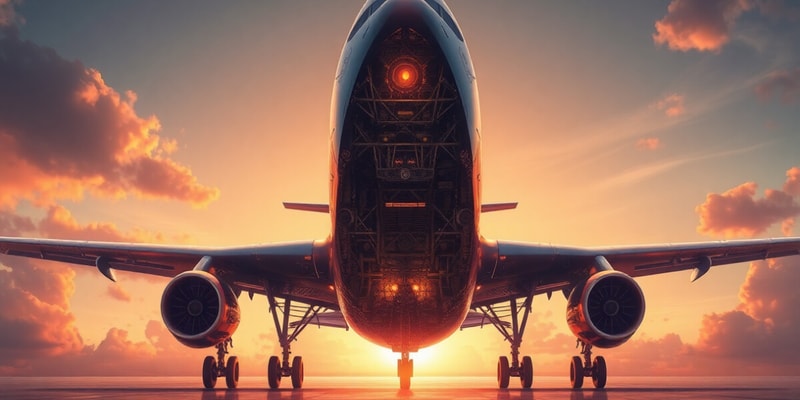Podcast
Questions and Answers
Which category of fixed-wing aircraft is regulated under FAR 25?
Which category of fixed-wing aircraft is regulated under FAR 25?
What are the primary considerations in determining an aircraft's configuration?
What are the primary considerations in determining an aircraft's configuration?
Which regulation governs Manned Free Balloons?
Which regulation governs Manned Free Balloons?
What do the acronyms FAR and CFR stand for in aviation regulations?
What do the acronyms FAR and CFR stand for in aviation regulations?
Signup and view all the answers
What are the categories of fixed-wing aircraft defined under FAR 23?
What are the categories of fixed-wing aircraft defined under FAR 23?
Signup and view all the answers
What is the Maximum Take-Off Weight (MTOW) limit for normal category fixed-wing aircraft?
What is the Maximum Take-Off Weight (MTOW) limit for normal category fixed-wing aircraft?
Signup and view all the answers
Which type of landing gear is primarily used in low-speed aircraft?
Which type of landing gear is primarily used in low-speed aircraft?
Signup and view all the answers
What is one advantage of retractable landing gear over fixed landing gear?
What is one advantage of retractable landing gear over fixed landing gear?
Signup and view all the answers
Which type of fuselage configuration is a common choice for conventional aircraft?
Which type of fuselage configuration is a common choice for conventional aircraft?
Signup and view all the answers
What type of aircraft does not fall under the normal category?
What type of aircraft does not fall under the normal category?
Signup and view all the answers
What is a feature of nose landing gear in aircraft?
What is a feature of nose landing gear in aircraft?
Signup and view all the answers
Which type of configuration is commonly associated with helicopters?
Which type of configuration is commonly associated with helicopters?
Signup and view all the answers
Which landing gear configuration poses a risk of nosing over during hard braking?
Which landing gear configuration poses a risk of nosing over during hard braking?
Signup and view all the answers
What is the primary function of the nose wheel in an aircraft?
What is the primary function of the nose wheel in an aircraft?
Signup and view all the answers
In the context of aircraft configuration, what determines the number of main landing gear on an aircraft?
In the context of aircraft configuration, what determines the number of main landing gear on an aircraft?
Signup and view all the answers
Which layout represents the most common configuration for the Boeing 747-400 passengers?
Which layout represents the most common configuration for the Boeing 747-400 passengers?
Signup and view all the answers
Which type of aircraft conversion is primarily concerned with altering the interior to accommodate cargo?
Which type of aircraft conversion is primarily concerned with altering the interior to accommodate cargo?
Signup and view all the answers
What is one of the modifications that can be made to convert a passenger aircraft to a freighter?
What is one of the modifications that can be made to convert a passenger aircraft to a freighter?
Signup and view all the answers
What is unique about the Boeing 747-400 V2 configuration compared to its V1 configuration?
What is unique about the Boeing 747-400 V2 configuration compared to its V1 configuration?
Signup and view all the answers
Which interior layout configuration includes the most rows for Standard World Traveller on the Boeing 747-400?
Which interior layout configuration includes the most rows for Standard World Traveller on the Boeing 747-400?
Signup and view all the answers
Which statement accurately describes the main landing gear of an aircraft?
Which statement accurately describes the main landing gear of an aircraft?
Signup and view all the answers
Study Notes
ME2511 Aircraft Structures
- Course covers aircraft configuration and internal layout.
- Learning objectives include understanding general aircraft configurations, construction, categories, and layout, focusing on business, freighter, and passenger aircraft.
Aircraft Configuration
- Fuselage, wing, tail structure configurations are key components.
- General fixed-wing aircraft configuration diagrams are presented, showing parts like the vertical stabilizer, rudder, APU exhaust, APU inlet, trailing edge flaps, aileron, wing rip, wing upper surface, upper fuselage, spoilers, leading edge slats, angle of airflow sensor, radomes, static ports, and pitot tubes.
General Aircraft Categories
- Aircraft are categorized based on customer needs.
- Categories include freighter, military, private, passenger, business, and government aircraft.
Aircraft Categories (FAR)
- Federal Aviation Regulations (FAR) govern aircraft categories.
- Categories include normal, utility, acrobatic, and commuter (FAR 23), transport (FAR 25), normal category rotorcraft (FAR 27), transport category rotorcraft (FAR 29), and manned free balloons (FAR 31).
- Hovercrafts are not considered aircraft.
Aircraft Categories - Maximum Take-Off Weight (MTOW)
- MTOW is a crucial factor in aircraft category designation.
- Normal, utility, acrobatic, and commuter category fixed-wing aircraft typically have an MTOW below 8600kg, and fewer than 19 passenger seats.
- Transport category fixed-wing aircraft fall outside the normal category.
Transport Category Aircraft
- Diagrams illustrate cross-sectional and plan views of narrow-body (e.g., Airbus A320) and wide-body (e.g., Boeing 747) aircraft, highlighting compartments like lavatories, galleys, passenger seats, cargo pallets, and overhead racks.
Unique Fuselage Shapes
- Various fuselage shapes are showcased, including the Aero Spacelines Super Guppy, Boeing 747 Dreamlifter, Short Skyvan, and Airbus A380.
Unique Wing Planform
- Different wing planforms, such as sweepback, elliptical, delta, and forward sweep, are illustrated.
Wing Configuration
- Wing configurations, including low wing, mid wing, high wing, inverted gull wing, gull wing, dihedral wing, and anhedral wing are displayed.
Wing Planform Configuration
- Various wing planform configurations, like low, moderate, and high aspect ratios, straight, swept, and forward swept wings are categorized.
Wing Planform Configuration 2
- More specialized wing planforms, such as elliptical, semi-elliptical, tailless delta, tailed delta, cropped delta, compound delta, ogival delta, crescent, cranked arrow, M-wing, and W-wing designs are addressed.
Empennage Section Configuration
- Various empennage configurations, including fuselage mounted, cruciform, T-tail, flying tailplane, tailplane mounted, twin tail boom, wing mounted, V-tail, inverted V-tail, X-tail, pelikan tail, and triple fins, ventral fin are illustrated
Common Empennage Section Configuration
- Common configurations like standard tail, twin tail, T-tail, and V-butterfly tail are detailed.
- These configurations are represented in diagrams.
Empennage Configuration
- Illustrations showcase fuselage mounted, T-tail, cruciform, and butterfly/V-tail, twin-tail design configurations.
Unconventional Aircraft Configuration
- Unconventional configurations such as flying wings (B2 Stealth Bomber), blended-wing aircraft, and the Bumble Bee & Proteus tandem-wing high-altitude aircraft are included.
Landing Gear
- Landing gear supports aircraft on the ground.
- Types: Fixed (low speed aircraft), retractable (more streamlined)
- Landing gear must be strong for landing forces.
- Gear assembly should be light, nose landing gear for steering, main for braking.
Landing Gear Configuration
- Conventional landing gear (pre-WWII aircraft), tail wheel for steering, possibility of nosing over during hard braking.
- Fixed and common in low-speed aircraft, nose wheel for steering during takeoff, no danger of aircraft nosing over during braking.
Landing Gear Configuration 2
- Retractable landing gear is standard in transport, business jets, and military aircraft.
- Increased performance due to reduced parasite drag.
- Nose wheel used for steering.
- Aircraft level during takeoff.
- Number of main landing gear depends on aircraft maximum landing weight.
Aircraft Engine Configurations
- Engine placements include to the nose, under the wing, through the wing, over the wing, and to the fuselage and tail section.
Aircraft Door/Air Stairs (ATR 42)
- Diagrams of the damper assembly, forward latch bolts, latch hooks, hinge seal, and inspection window are provided.
Passenger Aircraft (Airbus A380) Layout
- Detailed layout of the Airbus A380, featuring various compartments, like air conditioning plant, avionics, business class, first class, restaurant, stairs, cargo hatch and duty-free shop, wheel wells, baggage containers, wheel bogies, winglet, flaps, elevator to all decks, galleys, toilets, leading edge flaps, fuel tanks, stateroom, cabins, and pantry
- Parts of engine like fuel tanks, thrust reverse duct, and various fuel foams are also shown.
Passenger Aircraft (Boeing 787-8) Layout
- Detailed layout of the Boeing 787-8, including sections for cockpit, passenger cabins, engine and other parts.
Passenger Aircraft Interior Layout
- Illustrations showcase an economy class cabin interior of an Airbus A340-600 (Qatar Airways).
BA 747 Passenger Aircraft Configuration
- Descriptions for various Boeing 747-400 (744) passenger configuration types (V1, V2, V3), including different seating levels and passenger compartments.
Business Jet Interior Layout
- Image/diagram of a Falcon 7X business jet interior.
Passenger to Freighter Conversion
- Information found in YouTube video, and types of changes/modifications needed in aircraft layouts are referenced for conversion.
Freighter Aircraft Interior Layout
- Illustration of a Boeing 767-300 freighter aircraft interior.
Freighter A/C Internal Structure
- An image showing the internal structure of a freighter aircraft.
End
Studying That Suits You
Use AI to generate personalized quizzes and flashcards to suit your learning preferences.
Related Documents
Description
This quiz covers the fundamental concepts of aircraft structures as outlined in the ME2511 course. It focuses on understanding various aircraft configurations, internal layouts, and the categorization of different types of aircraft, including business, freighter, and passenger models. Gain insights into crucial components such as fuselage, wing, and tail structures, along with relevant regulations.




